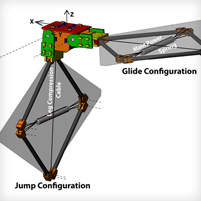A Leap Ahead

The tiny robot jumps from the ground to the top of the nearly vertical cliff, deep within an impossibly rugged terrain. It pauses, then spreads its wings and glides to a distant peak.
This is Matthew Woodward's vision — and it's more than just imagination.
The Carnegie Mellon University mechanical engineer has developed a miniature prototype robot that both jumps and glides. His robot is the first to incorporate two high-performance functions — achieved by integrating both into a single structure.
Woodward began his project as a master's student in professor Metin Sitti's class, trying to add a jumping mode to a climbing robot. He quickly became so intrigued by Sitti's NanoRobotics Lab that he stayed to earn his doctorate with Sitti as advisor.
Woodward also realized that simply adding on his project's second function caused both abilities to deteriorate. He turned to the animal kingdom for inspiration.
"Animals have, in many cases, developed strategies for integrating locomotion modes," Woodward explained. "The vampire bat uses its flying structure to actually jump. It can consume its own body weight and still jump off the ground high enough to get its wings open and fly away."
He also noticed that insects' jumping legs and birds' flying wings have almost identical components, except for the small interconnections.
"I started thinking about not what a structure does but what it could do," he said. "Birds could potentially jump with some small design changes. Because I'm an engineer, I can make those changes where nature has a little more trouble."
Woodward's transformer-esque vision resulted in a three-inch robot with eight-inch 'flying legs,' that can currently jump 20 feet and glide back down. He's looking forward to getting his creation "up and running — or up and jumping" outdoors this year for testing and refinement.
He envisions the potential of adding a flexible solar cell.
"When the robot starts running low on power, it could lay down, spread its wings, recharge, and then continue moving — set it down in the environment and walk away for a week."
Possible applications for the relatively inexpensive robot include interplanetary exploration, search and rescue, general environmental study and surveillance.
The Santa Barbara native came to Carnegie Mellon largely for its interdisciplinary capabilities.
"I chose Carnegie Mellon because of the close collaboration between the Robotics Institute and mechanical engineering," Woodward noted. "It's a really good environment and synergy. And the professors are always willing to sit down and talk. They're very knowledgeable and helpful, and that extends into the graduate community."
"I originally came thinking I'd only be here a year. Now I'm staying four or five."
Related Links: Robotics Institute | NanoRobotics Lab | Mechanical Engineering
